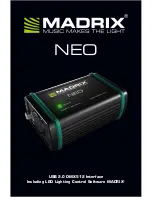
© Thermo
Scientific
, May 2003. Issue 7
19
RNA Probes
RNA probes are also derived from fragments, which have been cloned into specialised
cloning vectors. These vectors contain the promoter sequences of a bacteriophage
encoded DNA - dependent RNA polymerase (for example SP6 to T7) adjacent to a
multiple cloning site, into which the fragment is inserted. Transcription of the cloned
fragment in the presence of the specific RNA polymerase and a
32
P-labelled rNTP
results in labelled RNA. The template DNA is removed simply by DNAse digest. Vectors
of this type are available containing two phage promoters in opposite orientations
adjacent to the multiple cloning site so that the strand to be transcribed may be chosen
according to the phage RNA polymerase used. These RNA probes have become the
probes of choice for many applications, the only limitations being the additional care
required for handling RNA.
Synthetic Oligonucleotides
An oligonucleotide probe of a single defined DNA sequence may be synthesized if the
target
nucleic acid sequence is available using a DNA synthesis machine or commercial
service. Alternatively, pools of oligonucleotides of degenerate sequences may be
synthesized, derived from an amino acid sequence of a gene product. Due to the
degeneracy of the genetic code (i.e. most amino acids are specified by more than one
triplet codon) a given amino acid sequence will be coded for by a number of alternative
DNA sequences, one of which will represent the specific target sequence for the probe.
Oligonucleotides are most commonly radio-labelled using T4 Polynucleotide Kinase to
add a labelled phosphate group to the 5
′
terminus.
The various protocols of radio-labelling nucleic acid probes are widely available in the
published literature (e.g. Maniatis
et al
). In addition, there are several commercially
available kits containing all the components required for the different types of labelling
experiments.
High quality HPLC purified oligonucleotides are available online from Thermo
Scientific,
visit our web site at
www.thermo.com/molecularbiology
.
Содержание Shake 'n Stack 6244
Страница 13: ...2 4 Shake n Stack Thermo Scientific Section 2 Unpacking and Installation...
Страница 21: ...4 6 Shake n Stack Thermo Scientific Section 4 Methodology of Hybridisation...
Страница 27: ...7 2 Shake n Stack Thermo Scientific Section 7 Use of Radioactive Probes...
Страница 31: ...8 4 Shake n Stack Thermo Scientific Section 8 Technical Specifications...
Страница 32: ...Shake n Stack 8 5 Thermo Scientific Section 8 Technical Specifications...
Страница 33: ...8 6 Shake n Stack Thermo Scientific Section 8 Technical Specifications...
Страница 34: ...Shake n Stack 8 7 Thermo Scientific Section 8 Technical Specifications...
Страница 35: ...8 8 Shake n Stack Thermo Scientific Section 8 Technical Specifications...
Страница 36: ...Shake n Stack 8 9 Thermo Scientific Section 8 Technical Specifications...
Страница 37: ...8 10 Shake n Stack Thermo Scientific Section 8 Technical Specifications...
Страница 38: ...Shake n Stack 9 1 Thermo Scientific Section 9 Electrical Schematics...
Страница 39: ...9 2 Shake n Stack Thermo Scientific Section 9 Electrical Schematics...
Страница 40: ...Shake n Stack 9 3 Thermo Scientific Section 9 Electrical Schematics...
Страница 41: ...9 4 Shake n Stack Thermo Scientific Section 9 Electrical Schematics...
Страница 42: ......
Страница 50: ...A 8 Shake n Stack Thermo Scientific...
Страница 51: ...HYBRIDISATION GUIDE USER INSTRUCTION MANUAL Manual 7222060 Rev 0...
Страница 91: ......
















































